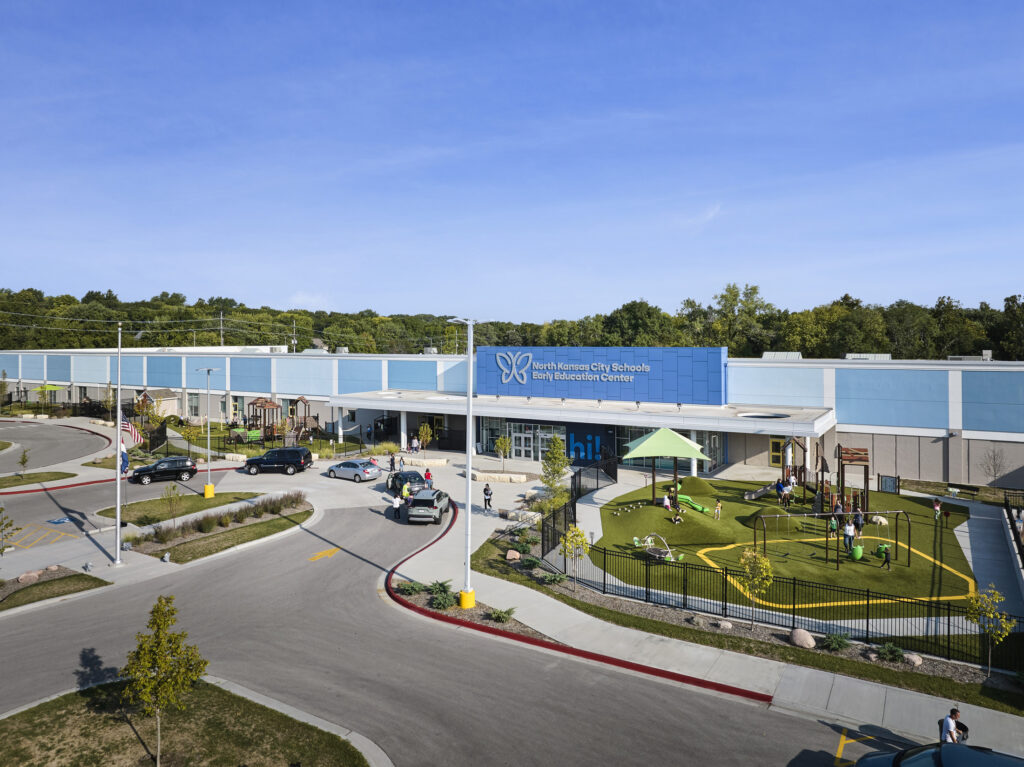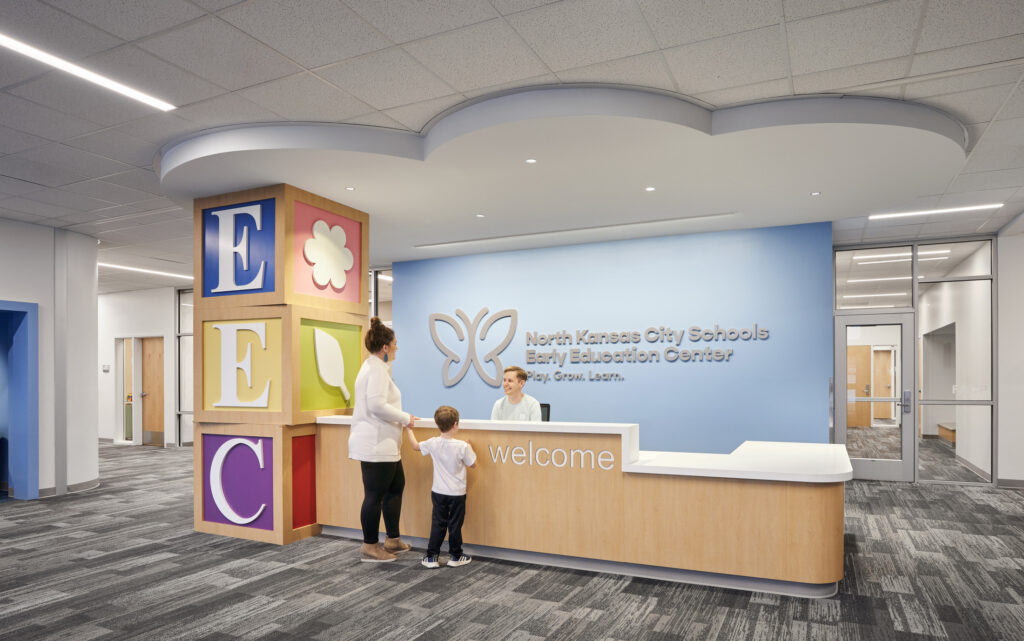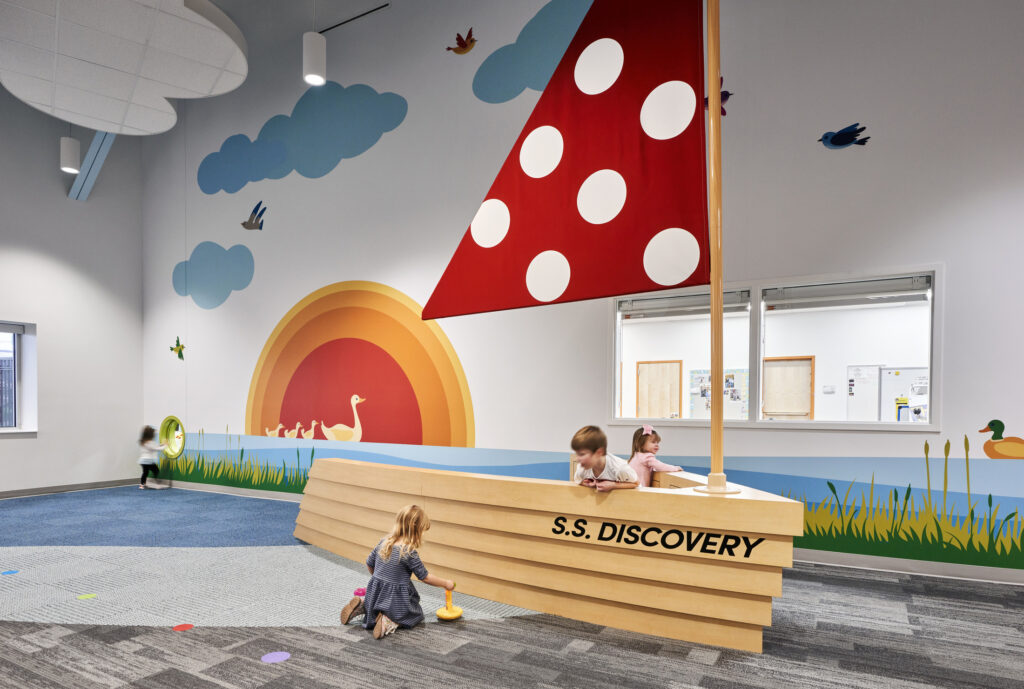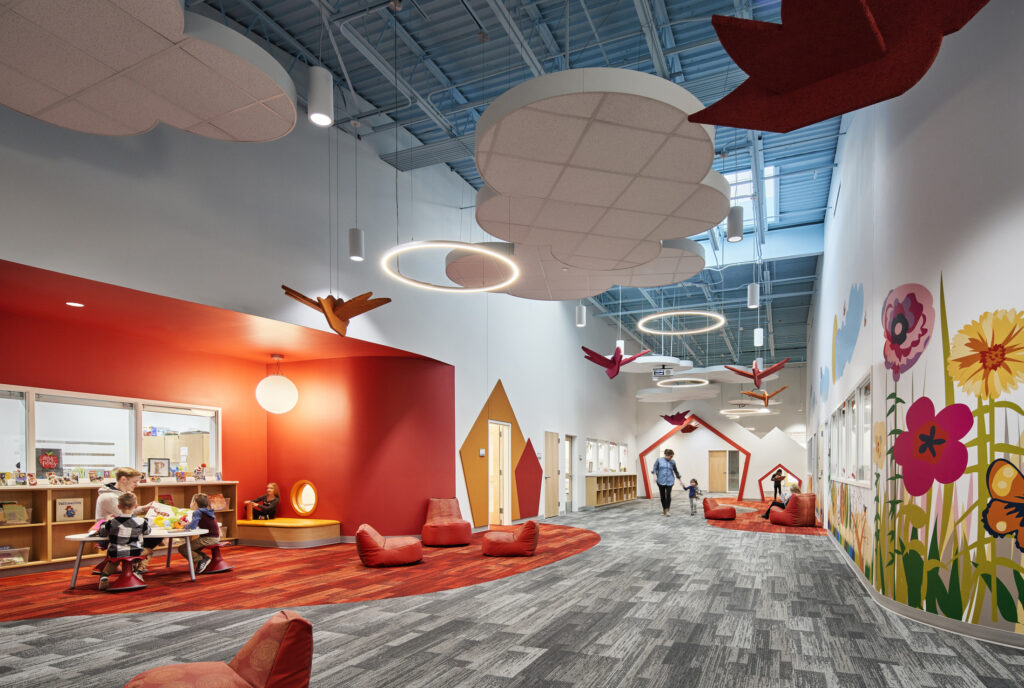As Dr. Katie Lawson walks the halls of the North Kansas City Early Education Center, she’s greeted by a student with a warm embrace. The student is eager to show Dr. Lawson, the executive director of special programs for North Kansas City Schools, what she’s been working on during small-group with her teacher.
These encounters are not rare for Dr. Lawson, or any of her colleagues. Nor is it irregular to meet a student who wants to share with you their joy for learning; in fact, you can find that just about everywhere you go throughout the North Kansas City Schools Early Education Center.
A space that was once a vacant Hobby Lobby and Price Chopper retail complex is now the catalyst to unlocking the joy of learning for nearly 1,000 North Kansas City preschool students. This was made possible through a collaborative process, orchestrated by DLR Group’s integrated design process, that prioritizes the student and educator experience and the community investment made in early childhood education.

Inception
In 2019, NKC Schools’ early education program was dispersed throughout the district, scattered across 22 classrooms in various buildings where space would allow and a converted elementary school consisting of nine classrooms that served as the primary hub. In addition to a wide-spread footprint, 50% of the students the early education program serves are special needs.
In addition, a local tax proposal would have limited access to early education for a number of students in the district. While this tax never came to fruition, NKC Schools was already working on a solution to this hurdle. The resolution was a larger, more centralized early education center.
NKC Schools needed to increase its classroom space by 50% to accommodate the needs of the early learners in their community. This transformative period also provided a window of opportunity for NKC Schools to better serve its nearly 400 special education learners, as well as the educators who inspire their learning.
From Grocery Store to Classroom
The bones of a once bustling retail center – a vacant Price Chopper and Hobby Lobby as the flagship stores – offered an opportunity to both the community of Gladstone and North Kansas City Schools. Long before the purchase of the parcel of vacant big box stores, representatives from the city of Gladstone approached the district about the possibility of repurposing the space.
Once it was determined a new facility would be needed to accommodate the district’s early education needs, the chance to revive a dormant portion of a community nestled in the heart of the district made it an easy choice to select the adaptive reuse approach for the project.
By electing to use adaptive reuse, NKC Schools saved 33% on the total cost of the early education center, and more importantly, provided a larger, more comprehensive space for their students and educators. The aggressive timeline for this project, 14 months from our first student shadow to the grand opening of phase 1 of the facility, was only attainable because of adaptive reuse.

A Unique Learning Adventure
To break down the scale of the big box store footprint, the school includes seven neighborhoods – each rooted in a different biophilic theme as well as associated color. Not only does this help with wayfinding but allows learners (and educators) to feel they have a smaller community within the greater whole of the campus.
Each neighborhood is comprised of four to six classrooms depending on the needs of the students in the neighborhood. They feature their own library and shared areas, including restrooms, storage, and swing spaces. Each neighborhood also features discovery zones, providing space for breakout sessions and additional sensory learning that occurs beyond the classroom.
We implemented nine-foot skylights in our design to provide a source of natural light into the neighborhoods. Each classroom is equipped with special light features that allow the teachers to change the tone of the lighting in their classroom, simulating calming or energizing light environments.
With limited space on the site, outdoor play environments are positioned along the main facade of the building. Not only does this soften the otherwise hard edge of parking and big box store, but it also creates an experience as users enter the building and hear the noise of learners playing outside.
To afford the maximum opportunities for all, each playground provides slightly different amenities. The smallest of the three is geared toward more special needs learners with more sensory focused play equipment, while the other two focus on gross motor and kinesthetic development.

The Voyages of the SS Discovery
Environmental graphics throughout the facility link the various biophilic themes in the pods into one cohesive facility. This experience, designed to be like the user is walking through a storybook, was quite literally translated into a storybook for young learners.
Whether digital or physical, this book allows users to familiarize themselves with the environment before ever attending school here and identify objects on the walls that they have seen in their storybook. Whether practicing colors, numbers, or animals, the graphics afford an opportunity to use the space as a learning tool.
Creating a Visual Brand Identity
Like any other school in the district, the early education center needed a logo and mascot. The brand identity needed to be simple, recognizable, and ultimately one that resonated with kids more than adults. As one of the themes in the building, a butterfly emerged as the symbol of growth and development – from a little caterpillar to a beautiful butterfly.

Collaborative Method
With the nature of adaptive reuse, the early education center is twofold in serving NKC Schools, as well as the community of Gladstone. In the most literal sense, a project like this takes a village. In our case, we saw complete and total buy-in from the school district, the community, and the state.
Successful bond referendums are made largely in part, if not entirely, by the community’s understanding of the need the bond will serve. Leaders within NKC Schools have taken the bond process and turned it into a formality. They ensure that all stakeholders in their community, not just the parents of students, are involved throughout the process.
Their efforts have led to numerous bond referendums being passed, including the $155 million ticket in June 2020 which supported the early education center among other district initiatives. That bond passed with nearly 80% approval in a community where most residents do not have school-aged kids. This is a testament to the commitment of the district and the community, working together.
Student and Staff Experience
For the student, the early education center has unlocked new ways to enjoy learning. It’s also brought a sense of community. It’s easy to point to the neighborhood model to exemplify this, but never have this many of NKC Schools’ preschool students been in the same facility at the same time.
For the educator, it’s given them the adequate space and the resources to be successful. This space was designed with the learner in mind, but it’s also tailored to the educator’s professional and personal needs.
The district has seen value in investing in its staff. NKC Schools has purchased the remainder of the strip center and is using adaptive reuse principles in its second and third phases of their project.
This space was designed with the learner in mind, but it’s also tailored to the educator’s professional and personal needs.
Phase two is comprised of a professional development center for all staff district wide, including those at the early education center. This centralized location will allow for more tailored training, enriching career development opportunities, and new office space for district administrators.
A new technology center and a district-sponsored coffee shop will also be a part of the second phase, totaling an additional 44,000 SF of refurbished space. The third phase is a space derived for adult education, bolstering NKC Schools’ commitment to special programming.
The long-term effect the early education center has on students will not be realized for quite some time. However, there are certain areas where educators are observing changes in how NKC Schools’ students interact with each other, approach learning, and are achieving learning objectives. Last year, students at the early education center entered kindergarten with a reading readiness level higher than the district average.

